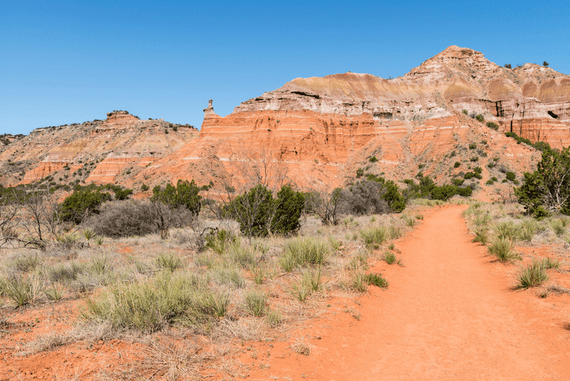Texas offers some of the best running and hiking trails in the United States. From lush forests to rugged canyons, the Lone Star State has diverse landscapes for outdoor enthusiasts to explore. The top 10 running and hiking trails in Texas include the Barton Creek Greenbelt in Austin, Guadalupe Peak Trail in Guadalupe Mountains National Park, and the Terry Hershey Park Hike & Bike Trail in Houston.

These trails cater to different skill levels and provide unique experiences. The Barton Creek Greenbelt stretches over 7 miles and offers more than just a running path. It's an adventure with scenic views and opportunities for rock climbing and swimming. The Guadalupe Peak Trail challenges hikers with a steep climb to the highest point in Texas.
For those seeking a mix of urban and natural settings, the Terry Hershey Park Hike & Bike Trail runs for nearly 11 miles in West Houston. It's well-shaded, making it ideal for running during hot Texas summers. These trails showcase the state's natural beauty and provide excellent options for both running and hiking in Texas.
The Allure of Texas Trails
Texas trails offer a diverse range of experiences for outdoor enthusiasts. From rugged mountain paths to serene coastal walks, the Lone Star State has something for everyone.
The state's varied landscapes provide breathtaking views that captivate hikers and runners alike. Rolling hills, deep canyons, and sprawling prairies create a stunning backdrop for outdoor adventures.
Texas is famous for its wildflowers, especially the bluebonnet. In spring, many trails burst with color as these iconic flowers bloom alongside other native species. This natural beauty attracts visitors from far and wide.
Scenic routes wind through state parks and natural areas, showcasing Texas's unique ecosystems. Hikers can explore dense forests, cross sparkling streams, and climb rocky outcrops all in one day.
The state's trails cater to all skill levels. Beginners can enjoy easy, well-marked paths, while experienced hikers tackle challenging terrain. This variety ensures that everyone can find a trail that suits their abilities and interests.
Texas trails also offer opportunities to spot wildlife, learn about local history, and connect with nature. Whether seeking solitude or a social experience, the trails of Texas deliver unforgettable outdoor adventures.
Top Trails for Hiking and Running

Texas offers amazing trails for hiking and running enthusiasts. Here are some of the best options:
Guadalupe Peak Trail is a challenging 8.4-mile round trip hike to the highest point in Texas. It provides stunning views of the surrounding desert landscape.
The Lighthouse Trail in Palo Duro Canyon is a 5.8-mile out-and-back trail. It leads to the iconic Lighthouse rock formation and offers beautiful canyon scenery.
Santa Elena Canyon Trail in Big Bend National Park is a shorter 1.7-mile round trip. This trail features impressive canyon walls and Rio Grande views.
Gorman Falls Trail at Colorado Bend State Park is a 3-mile round trip hike. It ends at a beautiful 70-foot waterfall, making it a rewarding journey.
South Rim Trail in Big Bend National Park is a longer 12-14 mile loop. It offers panoramic views of the Chisos Mountains and surrounding desert.
For runners, the Onion Creek and Homestead Loop Trails in Austin combine for a 6.5-mile loop. These trails have little elevation gain and pass through scenic McKinney Falls State Park.
Texas trails offer diverse landscapes and difficulty levels. From desert canyons to lush waterfalls, there's something for every hiker and runner to enjoy.
Trail Features and Difficulty Levels

Texas offers a wide range of running and hiking trails with varied features and difficulty levels. Trail difficulty is often rated as easy, moderate, or hard.
Easy trails are typically flat with smooth surfaces. They're great for beginners and casual walkers. These trails often have little elevation gain.
Moderate trails may have some elevation gain and uneven ground. They can include features like creek crossings or rocky sections. These trails are suitable for active hikers and runners.
Hard trails present more challenges. They often have steep sections, significant elevation gain, and rocky terrain. These trails test endurance and skill.
Many Texas trails offer scenic overlooks with stunning views. Hikers might see red rock cliffs, canyons, or diverse plant life.
Some trails follow rivers or creeks, adding natural beauty and the sound of running water. These water features can also pose crossing challenges on some routes.
When choosing a trail, it's important to consider personal fitness level and experience. Beginners should start with easier trails and gradually work up to more difficult ones.
Trail conditions can change due to weather. It's always wise to check recent trail reports before heading out.
Discover Unique Flora and Fauna

Texas trails offer a chance to see amazing plants and animals. The state's diverse landscapes create homes for many species.
On the Bluebonnet Trail, hikers can enjoy Texas' state flower. These blue beauties cover fields in spring, making a stunning sight.
Deer are common on many trails. They're often seen grazing in clearings or darting through woods. Keep an eye out for their graceful movements.
Armadillos are unique to the Americas. These armored creatures can be spotted on trails, especially in central and eastern Texas.
Squirrels are active year-round on Texas trails. Watch for them scampering up trees or foraging on the ground.
Lost Maples State Natural Area is known for its rare Uvalde bigtooth maples. These trees provide brilliant fall colors.
Texas trails also showcase cacti, yucca, and wildflowers. Each region has its own plant life to discover.
Bird watchers will enjoy the variety of species on Texas trails. From woodpeckers to hawks, there's always something to see.
Remember to respect wildlife. Observe from a distance and don't feed the animals. This keeps both hikers and animals safe.
Guide to Trail Amenities

Texas trails offer various amenities to enhance your hiking or running experience. Many popular trails provide parking areas for easy access. It's best to arrive early, especially on weekends, to secure a spot.
Bathrooms are available at many trailheads and visitor centers. Some trails have restrooms along the route, but it's wise to check beforehand.
Good hiking shoes are essential for comfort and safety. Trails in Texas can be rocky or uneven, so sturdy footwear with good traction is recommended.
Visitor centers are common at larger parks and preserves. They offer maps, information, and sometimes guided tours. Staff can provide updates on trail conditions and wildlife sightings.
Water fountains may be present at trailheads, but not always along the path. Bring enough water for your entire hike or run.
Some trails have picnic areas, perfect for a pre or post-activity meal. Others offer scenic overlooks with benches for resting and enjoying the views.
Remember to check the specific amenities for each trail before your visit. Amenities can vary widely between different locations and park systems.
Experiences at Texas State Parks

Texas state parks offer amazing hiking and running trails. Visitors can enjoy beautiful scenery and challenging terrain.
Palo Duro Canyon State Park has over 30 miles of trails. The park's colorful rock formations and deep canyons make for stunning views.
Hikers love Guadalupe Mountains National Park. It has Texas' highest peak and diverse ecosystems. Trails range from easy walks to tough climbs.
Colorado Bend State Park is great for waterfall chasers. The 1.5-mile trail to Gorman Falls rewards hikers with a 70-foot waterfall.
Lost Maples State Natural Area shines in fall. Its maple trees turn bright colors, creating a picturesque setting for hikes.
Enchanted Rock State Natural Area offers a unique experience. Visitors can climb the massive pink granite dome for panoramic views.
Seminole Canyon State Park has ancient rock art. Guided tours let hikers see Native American pictographs up close.
Many parks have campgrounds. This lets visitors enjoy starry nights and early morning runs or hikes.
Remember to bring water, sunscreen, and proper shoes. Check trail difficulty before starting. Always follow park rules and Leave No Trace principles.
National Parks' Prime Hiking Trails

Texas boasts several national parks with exceptional hiking trails. These parks offer diverse landscapes and unforgettable experiences for outdoor enthusiasts.
Big Bend National Park stands out with its rugged desert terrain. The park features over 150 miles of trails, ranging from easy walks to challenging backcountry routes.
Guadalupe Mountains National Park is home to Texas' highest peak, Guadalupe Peak. Hikers can tackle the strenuous 8.5-mile round trip to the summit for panoramic views of the Chihuahuan Desert.
Palo Duro Canyon, often called the "Grand Canyon of Texas," offers unique hiking opportunities. The Lighthouse Trail, a 5.75-mile round trip, leads to the park's iconic rock formation.
Popular trails in these parks include:
- Lost Mine Trail (Big Bend)
- Santa Elena Canyon Trail (Big Bend)
- Devil's Hall Trail (Guadalupe Mountains)
- McKittrick Canyon Trail (Guadalupe Mountains)
- CCC Trail (Palo Duro Canyon)
These trails showcase Texas' natural beauty, from towering rock formations to lush river canyons. Hikers should prepare for varying difficulty levels and weather conditions.
Each park provides distinct ecosystems and geological features. Visitors can expect to encounter diverse wildlife and plant species along the trails.
Urban Trails within Texas Cities

Texas cities offer great urban trails for running and hiking. These paths blend nature with city life, giving locals and visitors a chance to stay active.
The Barton Creek Greenbelt in Austin is a top choice. It spans over 7 miles and starts near Thiel Pediatric Dentistry. The trail offers more than just running - it's a full outdoor adventure.
Dallas has the Katy Trail. This 3.5-mile path was once a railroad line. Now, it's a popular spot for runners and cyclists in the heart of the city.
Houston's Buffalo Bayou Park has over 10 miles of trails. These paths wind through 160 acres of green space right in downtown Houston.
San Antonio's River Walk extends beyond the famous tourist area. The Mission Reach section adds 8 miles of trails along the San Antonio River.
Many Texas cities have botanical gardens with walking paths. These offer a mix of nature and exercise in urban settings.
Barton Springs in Austin is near several trails. Runners can cool off in its natural spring-fed pool after a workout.
Urban trails in Texas give people a way to stay fit and enjoy nature without leaving the city. They're great for all skill levels, from beginners to seasoned runners.
Iconic Landmarks and Views
Texas offers amazing sights for runners and hikers. From towering peaks to historic sites, the state's trails provide unforgettable experiences.
Monumental Mountain Trails
The Lighthouse Trail in Palo Duro Canyon is a must-see. This 5.8-mile round trip takes you to the base of the iconic Lighthouse rock formation. The trail offers great views of the canyon's colorful layers.
Enchanted Rock State Natural Area boasts a massive pink granite dome. The Summit Trail is a steep 0.8-mile climb to the top. From the peak, hikers can see for miles across the Texas Hill Country.
Guadalupe Peak Trail leads to the highest point in Texas. The 8.5-mile round trip is tough but rewarding. At the top, you'll find a monument and panoramic views of the Chihuahuan Desert.
Historic and Cultural Landmarks
The Mission Reach Trail in San Antonio connects five historic missions. This 15-mile path follows the San Antonio River. Runners and walkers can explore 300 years of Texas history.
Big Bend National Park's Lost Mine Trail offers both natural beauty and cultural significance. The 4.8-mile round trip climb reveals stunning vistas. It also passes areas once used by Native Americans.
The Fort Davis National Historic Site has trails around an 1800s military post. These paths give glimpses into frontier life. They also showcase the beauty of the Davis Mountains.
Planning Your Adventure
Getting ready for a running or hiking trip in Texas requires some preparation. First, choose a trail that matches your skill level and fitness. Look at the trail length, difficulty, and elevation gain.
Check the weather forecast before you go. Texas can be hot, so plan to start early in the morning when it's cooler. Bring plenty of water and snacks to keep your energy up.
Wear appropriate clothing and shoes for trail running or hiking. Dress in layers and don't forget sun protection like hats and sunscreen.
Some top parks in Texas offer great trails for both running and hiking. Research the park's facilities and rules before your visit.
Pack a small first aid kit and let someone know your plans. Bring a map or download a trail app on your phone for navigation.
Consider joining a local running or hiking group if you're new to the activity. They can provide valuable tips and companionship on the trails.
Remember to respect nature and follow Leave No Trace principles during your adventure. This helps preserve Texas's beautiful trails for future visitors.
What Hikers Say: Trail Reviews
Hikers in Texas have shared their experiences on various trails. Many praise the diverse range of hiking options available across the state.
The Lady Bird Lake Hike-and-Bike Trail gets positive feedback. Visitors call it a nice trail, though they advise starting early in hot months.
For those seeking a challenge near Dallas-Fort Worth, the Cross Timbers Trail stands out. Hikers and runners call it the best trail in the area.
Barton Creek Greenbelt is another popular spot. Reviews mention its beauty, but caution about crowds and heat in summer.
Trail reviews often highlight:
- Scenic views
- Difficulty level
- Wildlife sightings
- Trail conditions
- Best times to visit
Many hikers use apps to find and review trails. These apps let users share detailed descriptions, photos, and current trail conditions.
Reviews help other hikers prepare for their trips. They offer insights on what to expect, what to bring, and potential challenges.
Positive reviews often mention well-maintained paths, clear markers, and beautiful scenery. Negative feedback typically focuses on overcrowding, poor trail conditions, or lack of facilities.
DISCLAIMER
This document is provided for general information purposes only and should not be relied upon as providing legal advice, technical, or specific operational guidance to the reader, whether as to the practices described in the document or the applicable legal requirements and regulations. saveonsneaks.com expressly disclaims any responsibility for liability arising from or related to the use or misuse of any information in this document.



